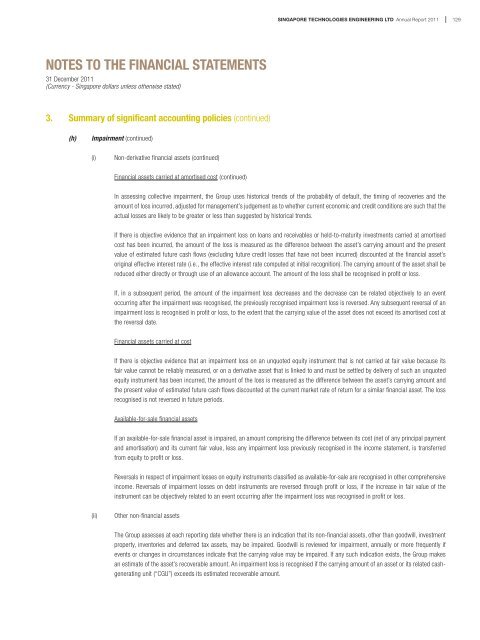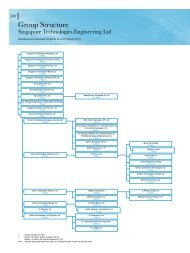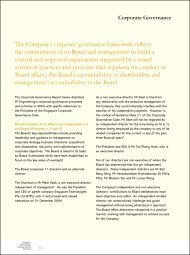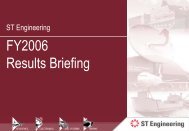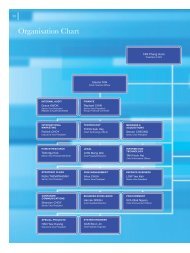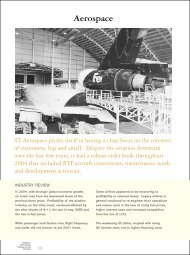notes to the financial statements - Singapore Technologies ...
notes to the financial statements - Singapore Technologies ...
notes to the financial statements - Singapore Technologies ...
You also want an ePaper? Increase the reach of your titles
YUMPU automatically turns print PDFs into web optimized ePapers that Google loves.
SINGAPORE TECHNOLOGIES ENGINEERING LTD Annual Report 2011129NOTES TO THE FINANCIAL STATEMENTS31 December 2011(Currency - <strong>Singapore</strong> dollars unless o<strong>the</strong>rwise stated)3. Summary of significant accounting policies (continued)(h)Impairment (continued)(i)Non-derivative <strong>financial</strong> assets (continued)Financial assets carried at amortised cost (continued)In assessing collective impairment, <strong>the</strong> Group uses his<strong>to</strong>rical trends of <strong>the</strong> probability of default, <strong>the</strong> timing of recoveries and <strong>the</strong>amount of loss incurred, adjusted for management’s judgement as <strong>to</strong> whe<strong>the</strong>r current economic and credit conditions are such that <strong>the</strong>actual losses are likely <strong>to</strong> be greater or less than suggested by his<strong>to</strong>rical trends.If <strong>the</strong>re is objective evidence that an impairment loss on loans and receivables or held-<strong>to</strong>-maturity investments carried at amortisedcost has been incurred, <strong>the</strong> amount of <strong>the</strong> loss is measured as <strong>the</strong> difference between <strong>the</strong> asset’s carrying amount and <strong>the</strong> presentvalue of estimated future cash flows (excluding future credit losses that have not been incurred) discounted at <strong>the</strong> <strong>financial</strong> asset’soriginal effective interest rate (i.e., <strong>the</strong> effective interest rate computed at initial recognition). The carrying amount of <strong>the</strong> asset shall bereduced ei<strong>the</strong>r directly or through use of an allowance account. The amount of <strong>the</strong> loss shall be recognised in profit or loss.If, in a subsequent period, <strong>the</strong> amount of <strong>the</strong> impairment loss decreases and <strong>the</strong> decrease can be related objectively <strong>to</strong> an even<strong>to</strong>ccurring after <strong>the</strong> impairment was recognised, <strong>the</strong> previously recognised impairment loss is reversed. Any subsequent reversal of animpairment loss is recognised in profit or loss, <strong>to</strong> <strong>the</strong> extent that <strong>the</strong> carrying value of <strong>the</strong> asset does not exceed its amortised cost at<strong>the</strong> reversal date.Financial assets carried at costIf <strong>the</strong>re is objective evidence that an impairment loss on an unquoted equity instrument that is not carried at fair value because itsfair value cannot be reliably measured, or on a derivative asset that is linked <strong>to</strong> and must be settled by delivery of such an unquotedequity instrument has been incurred, <strong>the</strong> amount of <strong>the</strong> loss is measured as <strong>the</strong> difference between <strong>the</strong> asset’s carrying amount and<strong>the</strong> present value of estimated future cash flows discounted at <strong>the</strong> current market rate of return for a similar <strong>financial</strong> asset. The lossrecognised is not reversed in future periods.Available-for-sale <strong>financial</strong> assetsIf an available-for-sale <strong>financial</strong> asset is impaired, an amount comprising <strong>the</strong> difference between its cost (net of any principal paymentand amortisation) and its current fair value, less any impairment loss previously recognised in <strong>the</strong> income statement, is transferredfrom equity <strong>to</strong> profit or loss.Reversals in respect of impairment losses on equity instruments classified as available-for-sale are recognised in o<strong>the</strong>r comprehensiveincome. Reversals of impairment losses on debt instruments are reversed through profit or loss, if <strong>the</strong> increase in fair value of <strong>the</strong>instrument can be objectively related <strong>to</strong> an event occurring after <strong>the</strong> impairment loss was recognised in profit or loss.(ii)O<strong>the</strong>r non-<strong>financial</strong> assetsThe Group assesses at each reporting date whe<strong>the</strong>r <strong>the</strong>re is an indication that its non-<strong>financial</strong> assets, o<strong>the</strong>r than goodwill, investmentproperty, inven<strong>to</strong>ries and deferred tax assets, may be impaired. Goodwill is reviewed for impairment, annually or more frequently ifevents or changes in circumstances indicate that <strong>the</strong> carrying value may be impaired. If any such indication exists, <strong>the</strong> Group makesan estimate of <strong>the</strong> asset’s recoverable amount. An impairment loss is recognised if <strong>the</strong> carrying amount of an asset or its related cashgeneratingunit (“CGU”) exceeds its estimated recoverable amount.


